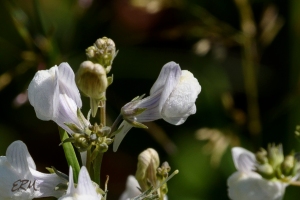And, back to Newfoundland, with a few more wildflowers I found in various locations,
 Pearly everlasting (Anaphalis margaritacea; Asteraceae) is found in Canada, New England, the northern Mid-Atlantic, the upper Mid-West, and the mountainous West; in Maryland it’s only in a few scattered locations.
Pearly everlasting (Anaphalis margaritacea; Asteraceae) is found in Canada, New England, the northern Mid-Atlantic, the upper Mid-West, and the mountainous West; in Maryland it’s only in a few scattered locations.

Oyster plant (Mertensia maritima; Boraginaceae) is found on beaches in northern North America and parts of Europe. I found it in Iceland last summer and specifically went looking for it when driving past Birchy Cove. It’s closely related to our showy native Virginia bluebells (Mertensia virginica).

Roundleaf sundew (Drosera rotundifolia; Droseraceae) is a carnivorous plant with circumboreal distribution; in the US it’s found in New England, the Appalachians, the upper Mid-West, scattered locations in the West, Canada and Greenland. In Maryland it’s found in Garret County and parts of the Coastal Plain. Look for it in sunny wetlands (bogs, fens, and so on).
 Gall-of-the-earth (Prenanthes trifoliata, formerly Nabalus trifoliatus or N. trifoliolatus; Asteraceae) is found in a variety of dry habitats in eastern Canada, New England, and south through the Appalachians. It’s endangered in Ohio, and though not on the RTE list in Maryland, is only known in Talbot County. Apparently it (and/or other Prenanthes species) was used in folk medicine, and has an exceedingly bitter taste, hence the common name.
Gall-of-the-earth (Prenanthes trifoliata, formerly Nabalus trifoliatus or N. trifoliolatus; Asteraceae) is found in a variety of dry habitats in eastern Canada, New England, and south through the Appalachians. It’s endangered in Ohio, and though not on the RTE list in Maryland, is only known in Talbot County. Apparently it (and/or other Prenanthes species) was used in folk medicine, and has an exceedingly bitter taste, hence the common name.
 Scots lovage (Ligusticum scoticum; Apiaceae) grows in rocky areas along the coasts of northern North America and Europe. It’s endangered in Connecticut and New York and special concern in Rhode Island. Supposdely it’s edible, tasting like lovage, which is to say like really strong celery.
Scots lovage (Ligusticum scoticum; Apiaceae) grows in rocky areas along the coasts of northern North America and Europe. It’s endangered in Connecticut and New York and special concern in Rhode Island. Supposdely it’s edible, tasting like lovage, which is to say like really strong celery.

Striped or creeping toadflax (Linaria repens; Plantaginaceae) is an alien found in only a few spots in North America. It’s native to Europe, and closely related to the more commonly occurring alien weed known as butter-and-eggs (L. vulgaris).

I spotted this Myosotis species (Boraginaceae) and photographed it from a great distance; there was no way to get close enough for a better picture or identification. The forget-me-nots are notoriously difficult to identify, as are their close relatives the phacelias, about which I’ve complained many times in this blog. But that borage blue is a beacon.
Yellow pond lily (Nuphar variegata, sometimes N. lutea ssp. variegata; Nymphaeaceae) is widespread in ponds across the northern US and Canada; it’s endangered in Ohio. The USDA PLANTS Database shows it present in Maryland but the Maryland Biodiversity Project has no records for it. The closely related spatterdock (N. advena) is found all over Maryland, though, including water pockets in cliffs in the Potomac Gorge.
In the same family is fragrant water lily, Nymphaea odorata. As you can see from the picture, I found both species growing together in one of the inunmerable ponds in the center of the Bonavista peninsula. Frgrant water lily can be found in almost every state and province of the US and Canada.
 American burnet (Sanguisorba canadensis; Rosaceae) is native to the eastern US and Canada as well as the Pacific Northwest; sadly, it’s threatened or endangered in nine states, including Maryland. It’s an eye-catching plant with its tall, fluffy spikes of flowers. Look for it growing in bogs and other wet areas (including roadsides).
American burnet (Sanguisorba canadensis; Rosaceae) is native to the eastern US and Canada as well as the Pacific Northwest; sadly, it’s threatened or endangered in nine states, including Maryland. It’s an eye-catching plant with its tall, fluffy spikes of flowers. Look for it growing in bogs and other wet areas (including roadsides).

Roseroot (Rhodioloa rosea, formerly Sedum rosea; Crassulaceae) is a subarctic plant found in a few parts of northern North America as well as in Iceland and Europe. I saw this one specimen flowering near Spillar’s Cove and am really kicking myself for not taking the time to get better pictures.
 Floodplains along the river are overflowing with Virginia bluebells (Mertensia virginica; Boraginaceae). Usually colored a pure, intense blue (I call it borage blue), the color can be lighter, or a pale violet, or all pink, or pure white.
Floodplains along the river are overflowing with Virginia bluebells (Mertensia virginica; Boraginaceae). Usually colored a pure, intense blue (I call it borage blue), the color can be lighter, or a pale violet, or all pink, or pure white. 
 Mixed in with these, and also found upslope in slightly drier soils, you can see wild blue phlox (Phlox divaricata; Polemoniaceae).
Mixed in with these, and also found upslope in slightly drier soils, you can see wild blue phlox (Phlox divaricata; Polemoniaceae). 
 Moss phlox (P. subulata) might be blooming by now. If not, it will within a week or so. Look for it sprawling over rocks; the plants stand only a few inches tall. The flowers are almost identical to those of wild blue phlox, but the plants’ growth habits are completely different.
Moss phlox (P. subulata) might be blooming by now. If not, it will within a week or so. Look for it sprawling over rocks; the plants stand only a few inches tall. The flowers are almost identical to those of wild blue phlox, but the plants’ growth habits are completely different.




















